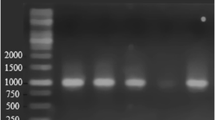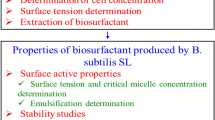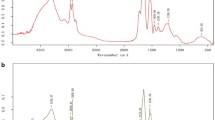Abstract
A halothermotolerant Gram-positive spore-forming bacterium was isolated from petroleum reservoirs in Iran and identified as Bacillus licheniformis sp. strain ACO1 by phenotypic characterization and 16S rRNA analysis. It showed a high capacity for bioemulsifier production and grew up to 60°C with NaCl at 180 g l−1. The optimum NaCl concentration, pH and temperature for bioemulsifier production were 4% (w/v), 8.0, and 45°C, respectively. Although ACO1 did not utilize hydrocarbons, it had a high emulsifying activity (E 24 = 65 ± 5%) on different hydrophobic substrates. Emulsification was optimal while growing on yeast extract as the sole carbon source and NaNO3 as the nitrogen source. The efficiency of the residual oil recovery increased by 22% after in situ growth of B. licheniformis ACO1 in a sand-pack model saturated with liquid paraffin.



Similar content being viewed by others
References
Bach H, Berdichevsky Y, Gutnick D (2003) An exocellular protein from the oil-degrading microbe Acinetobacter venetianus RAG-1 enhances the emulsifying activity of the polymeric bioemulsifier emulsan. Appl Environ Microbiol 69:2608–2615
Bach H, Gutnick DL (2004) Potential applications of bioemulsifiers in the oil industry. In: Vazquez-Duhalt M, Quintero-Ramirez R (eds) Petroleum biotechnology developments and perspectives. Elsevier, Amsterdam, pp 233–281
Banat IM, Makkar RS, Cameorta SS (2000) Potential commercial applications of microbial surfactants. Appl Microbial Biotechnol. 53:495–508
Banat IM (1993) The isolation of thermophilic biosurfactant producing Bacillus sp. Biotechnol Lett 15:591–594
Batista SB, Mounteer AH, Amorim FR, Tótola MR (2006) Isolation and characterization of biosurfactant/bioemulsifier-producing bacteria from petroleum contaminated sites. Bioresour Technol 97:868–875
Bodour AA, Maier RM (2002) Biosurfactants: types, screening methods and application. Encyclopedia of environmental microbiology, vol 2. Wiley, New York, pp 750–769
Bognolo G (1999) Biosurfactants as emulsifying agents for hydrocarbons. Colloid Surf Physicochem. Eng Aspect 152:41–52
Cameotra SS, Makkar RS (1998) Synthesis of biosurfactants in extreme conditions. Appl Microbiol Biotechnol 50:520–529
Cooper DG, Goldenberg BG (1987) Surface-active agents from two Bacillus species. Appl Environ Microbiol 53:224–229
Dubois M, Gilles KA, Hamilton JK, Rebers PA, Smith F (1956) Colorimetric method for determination of sugars and related substances. Anal Chem 28:350–356
Fujiwara K, Sugai Y, Yazawa N, Ohno K, Hong CX, Enomoto H (2004) Biotechnological approach for development of microbial enhanced oil recovery technique. In: Vazquez-Duhalt M, Quintero-Ramirez R (eds) Petroleum biotechnology developments and perspectives. Elsevier, Amsterdam, pp 233–281
Javaheri M, Jenneman G, Mcinerney MJ, Knapp RM (1985) Anaerobic Production of a Biosurfactant by Bacillus licheniformis JF-2. Appl Environ Microbiol 50:698–700
Jenneman GE, McInerney MJ, Knapp RM, Clark JB, Feero JM, Revus DE, Menzie DE (1983) A halotolerant biosurfactant producing Bacillus specie potential useful for enhanced oil recovery. Dev Ind Microbiol 24:485–492
Kaplan N, Zosim Z, Rosenberg E (1987) Reconstitution of emulsifying activity of Acinetobacter calcoaceticus BD4 emulsan by with pure polysaccharide and protein. Appl Environ Microbiol 53:440–446
Karanth NGK, Deo PG, Veenanadig NK (1999) Microbial production of biosurfactant and their importance. Curr Sci 77:116–126
Lang S, Wagner F (1987) Structure and properties of biosurfactants. In: Kosaric N, Cairns WL, Gray NCC (eds) Biosurfactants and biotechnology. Marcel Dekker, New York, pp 21–45
Luna-Velasco MA, Esparza-Garcia F, Canizares-Villanueva RO, Rodriguez-Vasquez R (2007) Production and properties of a bioemulsifier synthesized by phenanthrene-degrading Penicillim sp. Process Biochem 42:310–314
Martínez-Checa F, Toledo FL, El Mabrouki K, Quesada E, Calvo C (2007) Characteristics of bioemulsifier V2-7 synthesized in culture media added of hydrocarbons: Chemical composition, emulsifying activity and rheological properties. Bioresour Technol 98:3130–3135
Plaza GA, Zjawiony I, Banat IM (2006) Use of different methods for detection of thermophilic biosurfactant producing bacteria from hydrocarbon-contaminated and bioremediated soils. J Pet Sci Eng 50:71–77
Raymond RL (1961) Microbial oxidation of n-paraffinic hydrocarbons. Develop Ind Microbiol 2:23–32
Rosenberg E, Ron EZ (1999) High- and low-molecular-mass microbial surfactants. Appl Microbiol Biotechnol 52:154–162
Shabtai Y, Gutnick DL (1985) Exocellular esterase and emulsan release from the cell surface of Acinetobacter calcoaceticus. J Bacteriol 161:1176–1181
Simbert RM, Krieg NR (1994) Phenotypic characterization. In: Gerhardt P, Murray RGE, Wood WA, Krieg NR (eds) Methods for general and molecular bacteriology. Washington, DC, pp 607–654
Toren A, Orr E, Paitan Y, Ron EZ, Rosenberg E (2002) The active component of the bioemulsifier alasan from Acinetobacter radioresistens KA53 is an OmpA-like protein. J Bacteriol 184:165–170
Author information
Authors and Affiliations
Corresponding author
Rights and permissions
About this article
Cite this article
Dastgheib, S.M.M., Amoozegar, M.A., Elahi, E. et al. Bioemulsifier production by a halothermophilic Bacillus strain with potential applications in microbially enhanced oil recovery. Biotechnol Lett 30, 263–270 (2008). https://doi.org/10.1007/s10529-007-9530-3
Received:
Accepted:
Published:
Issue Date:
DOI: https://doi.org/10.1007/s10529-007-9530-3




